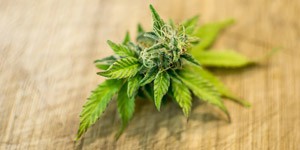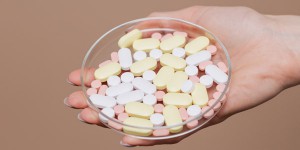By Ezra Pryor

Ezra Pryor studied geology and chemistry at the University of Maine, in the small town of Farmington. His grandmother, Prof. Phyllis Brown, was a female pioneer in the field of chromatography who received the EAS Award for Outstanding Achievements in Separation Science in 2006. Pryor took graduated studies in analytical chemistry at the University of Rhode Island, Kingston, and worked as a lab manager at the University of Southern California, in Los Angeles, before starting his own consulting company, EZ CHEM. Ezra has been serving the cannabis industry for over 5 years, assisting cannabis extractors in California to increase the safety and quality of their operations, before founding the Cannabis Chemistry Subdivision (CANN) within the American Chemical Society (ACS), for which he now serves as Past-Chair. He currently works as Applied Markets Specialist for Heidolph North America.
By Jahan Marcu

Jahan Marcu, Ph.D., is currently the Director of Experimental Pharmacology and Behavioral Research and Director of the Patient Focused Certification program, which is a health and safety oversight program that assesses regulatory compliance at cannabis operations. He is co-founder of the International Research Center on Cannabis and Mental Health and is on the scientific advisory board of the International Cannabis and Cannabinoid Institute (Czech Republic). He is also co-founder and past-chairman of the CANN subdivision of the Chemical Health and Safety Division of the American Chemical Society. His is also on the Board of Directors of the International Association for Cannabinoids as Medicine (Germany). He has a background in analytical chemistry and molecular pharmacology, he received his Ph.D. for contributions in characterizing the structure and function of the cannabinoid receptors. He is an author of the American Herbal Pharmacopeia's Cannabis Monograph and serves on multiple expert government, trade association committees, scientific organizations and is a court-qualified synthetic cannabinoid and cannabis expert. He has helped create medical cannabis educational training for clinicians and for workers in the medical cannabis industry, and has been invited to speak at many international conferences and universities. Dr. Marcu is a recipient of the Billy Martin research award from the International Cannabinoid Research Society.
Most of us talked to our parents at one point or another about cannabis. I had the opportunity to be open with my parents about my use of cannabis relatively early on. My mother had often expressed concern over my consuming this unregulated drug substance, "How do you know what's in it? What if you get some that is spiked with angel dust or something?" was her refrain. I would always say that cannabis works just fine the way it is and that it would cost more to add other drugs to it. The truth is I couldn't really know. This was two decades before the dawn of private cannabis testing labs that now are practically innumerable in the United States and growing in many other countries as well.
It turns out that my mother's concern for quality control was not unfounded. Though doping (adding other drugs to) cannabis is not unheard of, it is rare these days. What is not rare, unfortunately, is the contamination of cannabis with other substances by ignorance or by accident. These contaminants are varied in nature and their effect on the human body.
Contaminants are defined as "a polluting or poisonous substance that makes something impure." There are lots of definitions, but I like this one because it also touches on purity as well as poison. A contaminant is anything that reduces the purity of a cannabis product or poisons or pollutes the product by its presence. The word contaminant may be used to describe foreign or un-natural substances. In this article, however, I will also include components of the cannabis product with natural origins that detract from the quality or value of the product.
It is important to consider the nature of the final product when we define what makes a component of a cannabis product a contaminant or not. If we are infusing chocolate, the natural waxes in a cannabis extract cannot be considered a contaminant since chocolate is in large part composed of wax already. Chlorophyll is an example of something that is considered a contaminant in dabbable or vaporized extracts. Conversely, nobody has a problem with green buds or black hash oil (as an edible) despite the high chlorophyll content. This can be seen in the light color of most extracts destined for dabbing and the green color of whole cannabis flowers.
In general, we can divide the substances listed in this article into four categories: Natural Contaminants (such as plant chromophores and microbial contaminants), Poisons (such as heavy metals, radionuclides, and pesticides), Additives, and Combustion Products. In this article we will highlight some of the worst offenders and some solutions.
Natural Contaminants: Microbes and plant products
Cannabis contains many naturally occurring microbes which are benefit to the plant and should not be considered dangerous to the plant. These microbes help fight off plant pathogens. Cannabis is not a "disease-free" crop, a plethora of pathogens can attack the plant. Plant pathogens can threaten flowering tops, such as gray mold (Botrytis), white mildew or pink rot, and brown blight. These do not usually affect or infect humans, the exception being immunocompromised individuals such as those with AIDS or those undergoing Chemotherapy.
The worry of microbial contamination that affects consumers comes post-harvest, during storage and handling. This happens when the plants are dead and worrisome bacteria and fungus can infect a crop. Even if a crop is treated after infection post-harvesting, the dead bacteria and fungi are a concern as well, as these can lead to asthma, allergic reactions, and health issues related to mycotoxins.
Poisons: heavy metals, pesticides, and other nasty things
The most harm would undoubtedly come from the Poison category. This category includes heavy metals, pesticides, fungicides, unsafe solvents among other nasty things. In most cases these have been added to the plant during growth or in the extraction process. This typically is either the result of ignorance or indifference to the health and well being of the end user.
Heavy metals are of concern because of their ability to accumulate in the body until toxic levels are reached. One of your authors personally suffered from lead poisoning as a child and continues to live with the results of that poisoning today. Cannabis is a bioaccumulator, which means it readily pulls up heavy metals from soil. Phosphate ions are the main carriers of heavy metal contamination, and hydroponic fertilizers are particularly vulnerable to this type of contamination. McPartland and McKernan reported that fertilizers are targeted at cannabis growers have a noted problem with arsenic levels, additionally rockwool and other growth medium can be contaminated as well (See footnote 1).
Pesticide testing is considered more difficult than heavy metal, microbial or potency testing. Also, the secretive use of it, leaves consumers and regulators in the dark. One method we have used during inspections to determine what pesticides are being used is to visit grow shops near the cultivation operation. Careless and unethical operators in the cannabis industry sell and use re-packaged pesticides for landscape or ornamental crops. In the pantheon of unethical practices, one corporation went for the gold by marketing a product called Guardian (as "100% natural") which contained undisclosed abamectin. This jeopardized public health and resulted costly recalls across several cannabis programs in the United States. In 2005, the first case of hospitalization due to secretive pesticide use of abamectin was documented, after a trimmer was exposed to the contaminated cannabis. Unfortunately, since then the pesticide issue has ballooned. There have been several high-profile cases regarding cannabis and pesticides, including fines around $18,000 per issue, costly recalls, the quarantine of thousands of plants by regulators, and a consumer lawsuit regarding the undisclosed use of myclobutanil.
The good news is that pesticide residues continue to be a focus of recent studies, standards groups, and industry associations. This is the heart of self-regulation, and the organizations that implement best practices are starting flourish in this industry. But the issue of pesticides is being taken seriously by growers. The California-based International Cannabis Farmers Association is tackling the issue...providing guidance, resources, and research for farmers, regulators, and the public. "Our work on standards and education is laying the path for a cannabis and pesticide free world," said Kristin Nevedal, of ICFA. Additionally, groups to look to are the American Herbal Products Associate, ASTM (D37 the Cannabis Committee), and Patient Focused Certification.
Fertilizers can also contaminate Cannabis. Spraying plants with liquid fertilizers may result in the formation of N-nitrosamines, which are potent carcinogens. Four law enforcement officers contracted pulmonary histoplasmosis while pulling up marijuana plants that were likely fertilized with bird guano contaminated with fungus. For an illegal cannabis grow in Germany, perhaps guano wasn't available or too costly, so they used human dung, which was associated with outbreaks of hepatitis viral infections among cannabis consumers.
Additives
Additives are an interesting category on the list. These are intentionally applied to extracts to change viscosity, odor or flavor, and sometimes for subjective effects such as increasing energy or providing relaxing effects. In one particularly dubious case, lead was actually added to packaged cannabis for the illicit market, in order to increase its weight to charge consumers a higher price.
Many additives have questionable or unknown health effects on the consumer. Terpenes are a common additive, at the levels they occur in plants, such as cannabis, they are generally regarded as safe. However, when concentrated and consumed chronically, they may cause respiratory issues among other conditions. One product from a dubious company contained primarily fenchon as a terpene additive and ingredient, which is a terpene on the EPA's toxic watch list. While generally safe at low levels, in concentrated amounts terpenes can pose health risks according to some organizations.
Additives such as propylene glycol are questionable as well, readily forming carcinogens such as formaldehyde when overheated. The most common additives we have seen in creating extracts for vaporization is vegetable glycerin. This is one of the substances added to change the viscosity that it might function in disposable vape pen cartridges. Little is known on the safety of inhaling vegetable glycerin, which leads us to our next category of combustion products.
Combustion Products
The last category is combustion products. These are likely thought about the least and only relevant in smoked or dabbed products that are subjected to high heat and undergo pyrolysis. This is probably the most uniquely unpredictable risk for consumers, as cannabis is unlike other agricultural products, for example potatoes are not generally put through an extraction process for the purposes of being dabbed and inhaled.
Chemical reactions are often accelerated by temperature. For this reason, the chemical diversity of a cannabis product is increased tremendously when burned or subjected to high temperatures in a dab rig. Putting the issue of pesticides and heavy metals to the side, this is problematic because substances that were harmless before pyrolysis may become dangerous in their combusted form.
Conclusion/Contamination Harm Reduction Solutions
There are many things a producer or distributor can do to avoid these issues. To ensure that you have safe products first make sure the proper testing is done. Testing should be conducted for in-process and finished products. For example, testing a plant before extraction, the neat extract, the food or other product infused with the extract is a good practice. It can seem excessive, but this method allows you to determine where contamination may be occurring in the process if contamination is discovered.
If you are a distributor, you can incentivize going beyond the bare minimum of testing requirements by allowing these producers to receive a higher price for safer products. In the end, this makes sense for both parties because contamination can spread even after packaging, causing loss of more product than was initially contaminated.
If you grow cannabis, you can also get testing done to avoid contaminated cannabis and have tests done on everything that touches the plant. Soil tests can tell you if you have lead or other heavy metals in the soil. Tests can also determine if extraction machines or even your extraction solvent have been contaminated, preventing further batches from sharing the same contaminants by carry over. Nothing is worse than taking apart and cleaning an entire extraction machine only to run contaminated solvent through it, making it necessary to clean again.
Even if your state or country does not regulate the production of cannabis, there are easily accessible regulations for other states or countries that you can follow to ensure you are following best practices. Alternatively, there are best practices laid out in the American Herbal Pharmacopoeia's Cannabis Monograph and other sources.
Dilutants can often be replaced by safe substances. If you need to make your oil less viscous so that it works in a vape pen then adding additional terpenes that are present in cannabis can be a suitable solution, if the levels of the additives are properly controlled, and the proper grade of additives is used.
What can consumers do if they want to avoid contaminants like the ones listed here. First, and most importantly, select cannabis that has been tested by a third party if possible. If you have a legal cannabis source favor it strongly over black-market sources. When selecting a vape pen, avoid pens that have oil with a very low viscosity, if an air bubble moves through it as fast as vegetable oil, then it isn't pure. If you must smoke your cannabis, a water pipe will reduce the inhaled pesticides and combustion products. If you are not set on smoking, vaporizing is a good solution to inhaling cannabis without creating combustion products. When vaporizing though, make sure you are using the optimal temperature, as low temperature vaping can be the source of other issues. Additionally, those that analyze cannabis have often remarked that there is a significantly lower incidence of pesticides found in hash when compared to extracts.
All types of operators and consumers can benefit from engaging in third party certification. The more certification and accreditations, usually the better. These push products and services to higher standards, ahead of more strict regulations, and give the consumer a way to identify products that are certified to higher standards.
We don't mean to paint a bleak picture of the future or of the cannabis industry. Sometimes shedding light on what we don't see every day is the first step to getting our house in order. With the proliferation of cannabis testing labs and the data they are generating, we are all learning a lot about the industry and some very bad habits are being held to the light. As we learn and grow there are sure to be growing pains, but they are a sign we are moving in the right direction.
We can look to industry leaders and innovate companies to see where the solution to these problems lie. Bedrocan for example is a company that grows cannabis under GMP conditions and produce a finished flower product that meet pharmaceutical standards. Visiting their facility in the Netherlands, we were a bit shocked to see a seeming scarcity of personnel. Entire vegetative and flowering growth periods are performed with long periods of zero human contact with the plants. With such strict environmental controls, they have been able to literally standardize the plant product to within +/- 5% cannabinoid levels and no genetic drift over 20 years. When you compare this to the common practice of checking your plants daily by hand for mold or pests it is a big difference in procedures to achieve a similar goal.
As the industry moves forward, we can begin to expect, high quality, well regulated, properly labeled, safe cannabis every single time. It may be hard to tell when this will be, and it may vary on where you live also, but it has become an inevitability. Someday soon mothers will not need to worry about the cannabis their sons and daughters are consuming.

For a detailed review of cannabis contaminants please check out:
McPartland, J. M., & McKernan, K. J. (2017). Contaminants of Concern in Cannabis: Microbes, Heavy Metals and Pesticides. In Cannabis sativa L. - Botany and Biotechnology (Vol. 17, pág. 457–474). Cham: Springer, Cham. http://doi.org/10.1007/978-3-319-54564-6_22
Para obtener más información sobre la Subdivisión de Química del Cannabis de la American Chemical Society de la cual ambos autores son miembros fundadores, visite www.cannachem.org o busque canndchas en las redes sociales.
1. McPartland, J. M., & McKernan, K. J. (2017). Contaminants of Concern in Cannabis: Microbes, Heavy Metals and Pesticides. In Cannabis sativa L. - Botany and Biotechnology (Vol. 17, pág. 457–474). Cham: Springer, Cham. http://doi.org/10.1007/978-3-319-54564-6_22
2. Associated Press (2016) Oregon, other states stop sales of pot pesticide due to labeling problem. USA Today, 9 de febrero de 2016
3. Wyatt K (2015) Marijuana subject to product liability claim in Colorado. US News & World Informe, 5 de octubre de 2015
4. Shepard M (2013) Maine marijuana company fined $18 K for pesticides. Portland Press Herald, 6 de septiembre de 2013
5. Cates WC, Warren JW (1975) Hepatitis B in Nuremberg, Germany. Epidemiology of a drug-associated epidemic among US Army soldiers. JAMA 234:930–934 & Alexander T (1987) Hepatitis outbreak linked to imported pot. Sinsemilla Tips 7:22.
6. Busse, F. P., Fiedler, G. M., Leichtle, A., Hentschel, H., & Stumvoll, M. (2008). Lead Poisoning Due to Adulterated Marijuana in Leipzig. Deutsches Ärzteblatt International, 105(44), 757–762. http://doi.org/10.3238/arztebl.2008.0757


